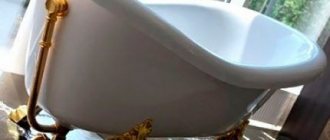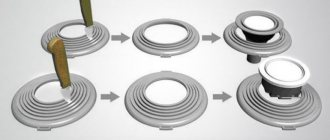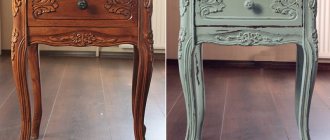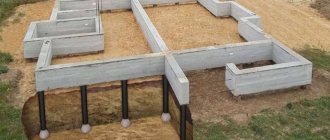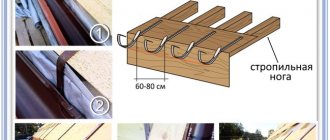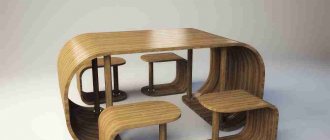Knowing the principle of operation of a turbo deflector, it is quite possible to make such a device with your own hands, spending one working day on assembly and installation. The simplest design and light weight make it possible to install the device on almost any chimney with an annular cross-section. The design of the turbo deflector looks quite attractive, so owners often install it on the chimney even for aesthetic reasons, instead of the old mushroom visor.
What is a turbo deflector
A very nice device, reminiscent in shape and size of a medieval oriental headdress - a turban. Essentially, this is a nozzle on the upper section of the ventilation pipe:
- The housing of the ventilation turbo deflector is a set of spiral strips of metal, assembled and fixed on a flat steel “top” - a platform;
- The design allows the pumpkin-shaped body to rotate at low speed around a vertical axis.
The rotation speed of the shiny body is low, only 3-5 rps, so a correctly installed turbo deflector in a slight breeze does not create any discomfort, does not make noise or squeaks.
For your information! According to owner reviews, installing a turbo deflector on the chimney is the best way to scare away annoying birds from a warm chimney.
In this capacity he has no equal. The moving shiny surface of the turbo deflector blades turns out to be much more effective than conventional weather vanes and stationary mushrooms above the ventilation pipe.
There can be no problems with traction
Ready-to-install rotary deflector
The purpose of any ventilation system is to remove polluted air and excess moisture from the premises, that is, to ensure normal air exchange. This will take place if the ventilation duct functions efficiently and correctly - the draft in it is excellent. If there are problems in this regard, they are often provoked by rain, snow, or wind masses entering the canal shaft.
What is a turbo deflector used for?
The first thing that comes to mind upon a superficial acquaintance with the device is the question of why it was necessary to make such a complex design for the nozzle on the chimney. After all, with proper planning of the chimney or ventilation, its performance should be abundant.
A turbo deflector is a device that can increase thrust in a pipe without using any additional energy sources. The unusual design of the nozzle does not have an electric motor, as in conventional supply and exhaust ventilation systems.
It is clear that a mechanical turbo deflector is inferior in air performance to systems based on electric fans, but more often the nozzles are on a pipe and are not designed to compete with powerful electric motors.
The nozzle is used for ventilation ducts or chimneys:
- In technical buildings with high levels of gas pollution or high humidity. You can install a ventilation pipe with a turbo deflector, and this will help get rid of basement dampness;
- In rooms and living spaces that remain closed most of the time, without constant heating. This usually reduces the efficiency of stationary supply and exhaust ventilation, so for such buildings they traditionally install low galvanized exhaust ducts with a nozzle;
- Buildings or private houses, sandwiched by neighboring buildings, with high terrain or plantings of trees, changing the profile and direction of wind flows above the roof.
The turbo deflector attachment for the pipe turned out to be very useful for a summer house or country house where there is no electricity, the room is heated once a week during the next visit on the weekend.
For your information! The characteristics of the turbo deflector are selected in such a way as to create additional draft to the existing vacuum in the main chimney pipe, nothing more. This device cannot replace a standard ventilation duct with a pipe.
Weather vanes
Pipe deflectors - weather vanes are also called weather vanes. Sometimes all chimneys in general are called this, but this is incorrect, because... A weather vane is, by definition, a rotating device.
The deflector on the pipe - weather vane can be made rotary, self-orienting and rotating. The latter are also called turbo deflectors, and self-orienting smoke teeth, which is also incorrect. The smoke tooth is part of the chimney of an English fireplace. The weak point of all weather vane deflectors is the bearing. It becomes very easily clogged and covered with soot, and the seals are subject to increased wear. Therefore, you need to inspect the weather vane deflector at least once every 2 months. But the weather vane deflector itself almost never becomes overgrown with the main enemy of all fixed deflectors - icicles.
Pipe deflectors - weather vanes
A multi-bladed weather vane deflector (items 1 and 2 in the figure) provides stable draft in winds of up to 9-10 points with minor loads on the pipe, so it can be installed on sandwich, ceramic and glass chimneys. A single-blade weather vane deflector puts a lot of stress on the pipe in a strong wind, so it must be strong and the house must be located in a place where the storm wind will not blow up. But a single-bladed weather vane deflector can easily be designed in the shape of a bird (items 3 and 4).
Turbo deflector (item 5) – remember and don’t trust anyone – not smoke! It is ventilated or for gas boilers with electric ignition. The turbine rotates both by the wind and by the air current in the pipe, and a correctly made turbine, as in some types of wind engines, is self-spinning: the weakest initial thrust or a light breath of breeze is enough for the turbine to spin and draw air, and it will stop only when the thrust , and the wind will stop completely. In a house ventilation system with turbo deflectors, you have to turn on the fans in the vents, as they say, once a year, not every year. Unfortunately, the turbo deflector is easily filled with dust and debris from the air, so it also needs to be checked at least once every 2 months.
The technical properties of the turbo deflector are the same as those of a multi-bladed self-orienting one, but it loads the pipe even less. It is quite possible to make a turbo deflector with your own hands, see the video below.
Is a turbo deflector worth the money?
Often, in an effort to avoid unnecessary heat losses during the heating season, owners build ventilation in the house with a minimum performance margin. In winter there is still enough capacity, but in summer the flow of fresh air is vital for a comfortable stay. In this situation, installing a turbo deflector on the pipe turns out to be a cheaper and more practical solution than reworking the chimney pipe or ventilation shaft in the house.
Another problem that most gardeners and summer residents have to face is related to storing crops in homemade cellars. It is not easy to regulate the humidity inside an earthen storage facility using a ventilation pipe, so the situation can be significantly improved by installing a turbo deflector on the hood.
In a similar way, you can get rid of condensation and excess humidity in the attic, in the glazed balcony or in the garage. Initially, the idea of using a rotating turbine was aimed at increasing the productivity of moisture removal and drying the under-roof space. Years later, it turned out that such an important advantage as ventilation with a turbo deflector without electricity can solve a lot of problems, including in old buildings with clogged and crumbling air shafts.
Of course, the size and weight of the turbo deflector are limited by the large windage of the structure, therefore, despite the attractive idea, it is practically impossible to completely provide ventilation of the room without the use of pipes, only using a blade system, and the effectiveness of such a solution would be low and would completely depend on the wind force at street.
Application area
turbo deflector
Turbo deflectors are installed in private and multi-storey residential buildings, industrial and agricultural facilities. In livestock complexes for humidity control and air purification. At processing facilities to reduce production costs. In crowded places and in houses surrounded by other buildings or trees.
Turbo deflector design
Therefore, the turbo deflector uses wind energy; a wind of 2 m/s is sufficient to increase draft in the ventilation system or chimney. The maximum air flow speed is usually limited to 20 m/s.
The design of the deflector nozzle for the pipe consists of three parts:
- The body is a turbine made of two dozen thin metal blades with a curved surface;
- Shaft with bearing support connected to the housing;
- Mounting ring installed on the ventilation pipe. In the center of the ring there is a support sleeve to hold the shaft in a vertical position.
Previously, the turbo deflector was sold with the expectation of installation on round galvanized pipes used in the installation of modern ventilation ducts. Today you can buy several options for adapters and mounting rings that ensure reliable retention of the device on an asbestos-cement pipe or brick edge of a ventilation shaft.
Advantages and disadvantages
The main advantage of the rotary deflector is an increase in draft in the exhaust duct by an average of 20%. This is achieved due to the formation of air vacuum at the inlet of the turbo deflector during its operation. The increase in thrust will depend on the rotation speed of the active head, and its speed on the air flow speed.
Briefly, the following advantages of a rotating deflector can be highlighted:
- complete autonomy;
- eliminating the influence of weather factors (precipitation, sharp gusts of wind) on air exchange;
- increase in traction by ~20% at minimal cost;
- elimination of “backdraft”;
- low cost with a significant increase in the efficiency of the ventilation system;
- protection of ventilation shafts from foreign objects entering them;
- reduction of fat deposits and dust in ventilation ducts;
- long service life (at least 15 years);
- no special skills required for installation;
- Possibility of decorative design of the channel outlet.
The main disadvantage of the device is the dependence of its effectiveness on weather factors, namely the lack of wind. In complete calm, such a device ceases to perform its unique function, but at the same time its other qualities remain in effect, like a regular standard deflector.
Another disadvantage is the icing of the turbine in the winter season. In this case, you will have to knock off the ice film from the blades to restore the operation of the mechanism.
How does an air turbine pipe attachment work?
The operating principle of the turbo deflector is based on the effect of asymmetric air flow around the dome-shaped body of the device. Regardless of the direction and strength of the wind, the air flow, moving perpendicular to the axis of rotation, flows around the left half at a lower speed than the right. When interacting with the open edges of the blades, the air flow is slowed down and at the same time imparts rotation to the body.
On the right half of the turbo deflector wheel, the blades face in the opposite direction, so the incoming air flow flows around the surface without resistance and loss of speed. As a result of the Bernoulli effect and centrifugal force, flue gases or polluted air are thrown out of the housing at a speed only 30% slower than the wind. True, the gases ejected from the turbo deflector are dispersed unevenly in the surrounding space.
Why do you need a deflector?
For a better understanding of the issue, we present data from reference literature. The magnitude of local resistance to air flow in ventilation systems is characterized by a dimensionless coefficient. The greater its value, the stronger the shaped element - umbrella, elbow, gate - slows down the movement of gases through the pipeline.
In relation to our cases, the coefficient is:
- at the exit of the air flow from an open pipe of any diameter ξ = 1;
- if the channel is covered with a classic cap, ξ = 1.3–1.5;
- a Grigorovich umbrella with a diffuser (section expansion) is installed on the pipe, ξ = 0.8;
- Volper nozzle is cylindrical or star-shaped “Shenard”, ξ = 1;
- TsAGI type deflector, ξ = 0.6.
Note. There is no mistake here - even with free release from the shaft, the air stream overcomes local resistance from sudden expansion. Source: Handbook of Heating and Ventilation, 1976 edition.
So, a deflector is a nozzle that, under the influence of wind, creates a vacuum at the outlet of the vertical ventilation duct and thus reduces the aerodynamic resistance to the flow. That is, it acts as a traction amplifier.
In addition, the exhaust device solves the following problems:
- protects the air duct from precipitation;
- does not allow the wind to blow inside the pipe;
- prevents the occurrence of reverse thrust (overturning).
The operating principle of any deflector is based on two effects: vacuum from the wind load and ejection (entrainment) of a slow gas flow by a faster one. Although some foreign manufacturers implement mechanical incentives - they simply equip the umbrella with an electric fan. Let us consider the structure of each design separately.
From this angle it is clearly visible that the cross-section of the lower nozzle pipe does not decrease, which means that the speed and pressure of the gases does not change
Comment. On the Internet, the operation of such caps is often explained by the action of Bernoulli’s law or the Venturi effect. Both physical phenomena involve a narrowing of the air duct, an acceleration of flow and a drop in pressure. In reality, deflectors do not reduce the cross-section of the channel (see photo above) - the vacuum is created solely by the force of the wind.
Turbo deflector performance
There are quite a large number of estimates of the efficiency and performance of a turbocharged deflector, from advertising statements about increasing pipe thrust by 4-6 times, to minimalist estimates of 20-30%.
In reality, the increase in thrust using a turbo deflector in ideal conditions and with average winds is 150-250%.
As can be seen from the graph, the theoretical performance of the device increases almost linearly with increasing wind speed over the pipe. In practice, such growth is only possible if it is possible to place the turbo deflector in the most favorable location on the roof.
see also
- Ventilation adapter for extractor hood
- How to properly ventilate oyster mushrooms
- Stainless steel ventilation production
- How to make ventilation in a frame house with your own hands
- Calculation of the cross-section of the ventilation duct for natural ventilation
- Ventilation in the grow box
- Corrugated air ducts for ventilation
- Passat b5 crankcase ventilation valve
- How to check ventilation in an apartment
- Crankcase ventilation valve for Lada Granta
- Loggia ventilation during insulation
How to calculate the performance of a turbo deflector
Typically, a turbo deflector is simply placed at the outlet of a vent or chimney without any additional flow analysis, and the base value is used to calculate the performance of the turbo deflector. This value is indicated by the manufacturer in the labeling of the turbomachine; for example, the most popular model TD 400, according to its passport, has a capacity of 400 m3/h with a base wind speed of 2 m/s.
To calculate the required number of turbo deflectors, it is enough to take the required air exchange rate in the room and multiply the coefficient by the volume of the room. Next, the resulting value in cubic meters of air is divided by the basic performance of the turbo nozzle, and the number of devices is obtained.
Turbo deflector dimensions
The popularity of the turbocharged nozzle is quite high; it is widely used for private households, apartment buildings and even in the construction of industrial facilities. The smallest diameter of the ventilation pipe is 100 mm, the largest size of the ventilation shaft is 1000 mm.
In addition to models with a classic round seat ring, turbo deflectors with transitional box-shaped bases are also produced. Such nozzles can be installed on ventilation ducts on high-rise buildings made of bricks and blocks.
For your information! It is believed that the turbo deflector maintains its performance characteristics if the area of the landing ring differs from the quadrature of the pipe or shaft cross-section by no more than 15%.
In practice, when choosing a suitable turbo nozzle option, preference is usually given to models with higher productivity; the nozzle efficiency is higher, although it increases the load on the pipe.
Installation features
The factory turbo deflector is a one-piece design, ready for installation. It has an active movable top and a base that includes zero-drag bearings. The product is designed in such a way that even in a strong gusty wind it will not tilt or blow down.
Deflector with polymer protective coating
In conclusion, we would like to note that rotational deflectors are the most expensive in their segment. In this case, the consumer is asked to choose a suitable structure made of stainless steel, galvanized or structural steel with a protective polymer coating, the color of which can be matched to the façade design. Of course, the type of material from which the deflector is made affects its cost.
Tags: ventilation, deflector, hand, your own, drawing
« Previous entry
How to make a turbo deflector with your own hands
There are two options for a homemade turbocharged nozzle that you can build with your own hands, the performance of which will be only slightly inferior to industrially manufactured products.
In the simplest case, the housing of the turbo nozzle for ventilation can be made from a cylindrical steel container.
To make blades, just make vertical cuts and bend the edges outward. The housing is mounted on the axis of rotation without any bearings; the mounting ring is cut out of a piece of metal chimney and secured to the ventilation with a regular clamp. The appearance of a homemade turbo deflector is inferior to industrially manufactured models, so such products are used primarily for ventilation pipes in cellars and outbuildings.
For the second option, you will need to make a drawing or use the dimensions from the photo below.
First of all, you need to make a fastening; for this, a strip with a thickness of at least 3 mm is best suited.
The diameter of the ring can be taken from the diagram, but it is better to first measure the pipe along the cut edge.
The second important element is the shaft and bushing.
The steel grade and diameter are not particularly important, the main thing is that the parts are made of the same material.
Types of deflectors
To improve the performance of the ventilation system, there are many types of deflectors on sale. Some of them are static, others are rotational. The latter include turbines in which the impeller head rotates, operating due to the power of the wind.
Note! Regardless of whether the deflector has a static body or a rotary one, they are all made to improve draft in the chimney or ventilation duct. They protect the system from precipitation and debris. However, the most effective device can confidently be called a turbo deflector.
Rotary turbines can be classified according to the following parameters:
- Material of manufacture. Deflectors are made from stainless steel, galvanized or painted metal, aluminum.
- The diameter of the nozzle or connecting ring is a minimum of 110 mm and a maximum of 680 mm. It is clear that the dimensions are identical to the diameter of the sewer pipes.
Despite the fact that manufacturers produce modifications of turbo deflectors that practically do not differ from each other in appearance, their characteristics are different. Below is some information about these products:
- Turbovent. The company of the same name produces rotary ventilation products made of aluminum. The products have a thickness of 0.5 to 1 mm. The base is made of galvanized steel, thickness from 0.7 to 0.9 mm. The turbo deflector can be painted in any of the colors according to RAL standards;
- Turbomax. Manufacturers make sales by calling the product a natural traction booster. To create a deflector, AISI 321 steel is required, the thickness of which is 0.5 mm. Scope of use: both for natural ventilation systems and for stove and fireplace chimneys. And this is not in vain, since the turbo deflector is able to withstand temperatures up to +250 ℃. Products are made from high quality stainless steel.
You can also find products from unknown brands on store shelves. Such products should be purchased carefully, paying attention to the certificate. Better yet, make a turbo deflector for ventilation with your own hands. Drawings and appropriate instructions are needed.
Drawings of turbo deflector blades
The most complex element of a turbocharged nozzle is the blade or blades.
Since the turbo deflector body is formed by bent profiled elements, the main condition for a high-quality attachment will be the accuracy of the geometry of each blade.
As an example, you can use the diagram in the photo.
To bend the workpiece, you need to step back 20 and 60 mm from the edge and draw a bend line. Next, we retreat 12 mm from the front edge and mark the points for drilling three holes.
All that remains is to bend and rivet the blades to the top cover of the turbo nozzle.
Installing a turbo deflector
Mounting to a pipe is not particularly difficult or labor-intensive. To install the deflector, you only need to align the nozzle body with the axis of the ventilation pipe.
If the diameter of the mounting ring turns out to be slightly larger than the cross-section of the pipe, then the problem is solved by winding up the spacer material; you can use tin or thin galvanized metal. Rubber gaskets cannot be installed, in this case the turbo deflector and pipe will rot in a few months.
After alignment, the body is fixed to the pipe cut with four self-tapping screws.
Can it be installed on a chimney?
By installing a deflector, unlucky homeowners are trying to solve the problem of lack of draft. This happens when the chimney pipe is made incorrectly - the head falls into the zone of wind support of the roof, is raised to a low height, or a neighbor has built a tall building nearby.
The best solution for insufficient draft is to raise the chimney to the required height. Why is it undesirable to jam various attachments onto the head:
- It is prohibited to place umbrellas and other exhaust devices on pipes that discharge combustion products from gas boilers. These are safety requirements.
- When burning, stoves and solid fuel boilers emit soot that settles on the internal surfaces of chimneys and caps. The deflector will have to be cleaned, especially the rotating one.
- At the bottom of a properly constructed smoke channel there is a pocket for collecting condensation and excess moisture. There is no point in covering the pipe from precipitation; it is enough to attach a nozzle at the end that protects the insulation of the sandwich.
The heads of stove flues can be equipped with umbrellas, but a turbo deflector is definitely not needed there. The topic of installing hoods on smoke exhaust ducts is covered in detail in a separate material.
Operation of the turbo deflector
The design of the turbo nozzle is quite unpretentious and reliable. If the rotating cap is installed on the pipe according to all the rules, then the turbo system can serve without maintenance for several years in a row.
Experts recommend that after installing the turbo deflector, remove the cap every two years, check and lubricate the bearing. For high-speed small-sized turbochargers, you can use motor oil; other models are lubricated with Litol or any other high-quality grease.
The most unpleasant incident that happens with a turbo deflector is associated with freezing of condensing moisture along the edge of the pipe. The design will not suffer from this, but the efficiency of the turbo nozzle is reduced to zero.
Owner reviews about the turbo deflector for ventilation
Sergey Alexandrovich Zaslavsky, 33 years old, Novorossiysk
The idea of installing a turbo deflector on the garage and cellar ventilation pipe was suggested by a neighbor. I installed the turbo head myself in half an hour, without even checking the quality of the bearing lubrication. As if on purpose, half an hour later a rain squall came. The turbo deflector roared like a turbine, but there wasn't a drop of water in the garage. I liked the work of the nozzle, I will definitely make it for the attic and for the boiler room pipe.
Viktor Anatolyevich Spesivtsev, 68 years old, Omsk
At first I didn’t even believe in the capabilities of the rotating attachment; it looks like a beautiful toy, nothing more. My son gave it to me, I had to install it. I have a canopy attached to my house, and it’s hellishly stuffy under it at noon. I put it on the roof for testing, I liked the result. I bought four of them and put them on the roof of the house. The neighbors laughed, but this year I saw two of them, they were also standing, which means they assessed it correctly. The only drawback is the high price.
Vladimir Barlevich, 45 years old, Moscow
I don’t recommend installing it, I had a turbo deflector at my dacha, no effect. I moved it to a pipe in the outbuilding, closer to the road, and a week later it was stolen. The neighbor says that he placed it incorrectly, they wouldn’t have taken the trinket, but since it was stolen, it means the thing is worthwhile.


